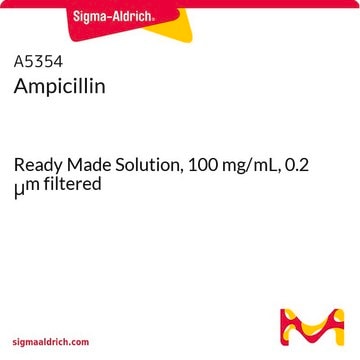The product is stable for nearly 3 years when stored at room temperature. There is no specific requirement to store L2542 at 2-8°C. However, if the container is opened and closed, there is a possibility of contamination through routine use.
L3522
LB Broth (Miller)
Highly-referenced nutrient-rich microbial growth powder medium, suitable for regular E.coli culture
Synonym(s):
Luria Broth, Miller’s LB Broth
About This Item
Recommended Products
grade
for molecular biology
Quality Level
description
Miller′s Modification, 10 g/L NaCl
sterility
non-sterile
form
powder
composition
NaCl, 10 g/L
Tryptone, 10 g/L
Yeast Extract, 5 g/L
pH
6.8-7.2(2.5% solution)
application(s)
food and beverages
storage temp.
room temp
suitability
nonselective for Escherichia coli
nonselective for coliforms
General description
Application
Suitable for non-selective cultivation of E. coli strains for cloning, DNA plasmid production and production of recombinant proteins. Also suitable for selective cultivation when appropriate antibiotics are added.
Biochem/physiol Actions
Features and Benefits
- Easy scale-up using larger package sizes
- A budget-friendly alternative to liquid
- Standard formulation
Preparation Note
2. Autoclave for 15 minutes at 121 °C.
To prepare the medium of Luria, Adams and Ting (also known as LC broth: Aseptically add 25 ml of sterile 0.1 M calcium chloride after autoclaving.
Reconstitution
related product
Storage Class Code
11 - Combustible Solids
WGK
WGK 3
Flash Point(F)
Not applicable
Flash Point(C)
Not applicable
Choose from one of the most recent versions:
Already Own This Product?
Find documentation for the products that you have recently purchased in the Document Library.
Customers Also Viewed
Articles
Genetic engineering enables large-scale expression and isolation of recombinant proteins for research purposes.
SeqPlex™-I WTA kit amplifies RNA for NGS, enabling genomic studies from limited samples.
Protocols
General protocols for growth of competent cells in microbial medium.
Related Content
KOD One™ PCR Master Mix overview for ultra-fast PCR with high specificity, fidelity, and yield
-
What is the recommended duration for using this item after autoclaving, and can it be stored at 4 degrees Celsius for extended or long-term use?
1 answer-
Helpful?
-
-
What are the differences among the Luria, Lennox and Miller LB formulations?
1 answer-
LB, (originally termed lysogeny broth) was initially composed of tryptone, yeast extract, NaCl and glucose. Soon after, the glucose was omitted (Miller's version), and later the NaCl content lowered by half (Lennox's version). For some applications, even lower salt is required (Luria's low salt version).
Helpful?
-
-
Which bacterial culture medium is the best choice for my application?
1 answer-
Each of the broths will likely grow E. coli very well, but there are still general guidelines for choosing a broth when you are working without a protocol. Generally:LB - Miller and LB - Lennox are used for E. coli growth and maintanence, DNA plasmid production and protein production. The Lennox formulation has a lower salt content required for some salt-sensitive selection antibiotics.LB - Luria low salt is used for special applications where the E. coli growth or other constraints require the lowest possible salt content.Terrific Broth is used for higher yield protein production and high yield DNA plasmid production, because of the faster growth of the E. coli in this medium.SOB is used for protein production, DNA plasmid production and the generation of high-efficiency competent cells.SOC is used for initial growth of competent cells and the transformation procedure.
Helpful?
-
-
Will adding magnesium to the culture medium increase cell density?
1 answer-
In microbial broth formulations that do not already contain magnesium, the addition of 10-20 mM MgCl2 or MgSO4 may increase cell densities. You may need to also increase the shaking speed of the incubator.
Helpful?
-
-
What is the difference among the LB - Miller products?
1 answer-
LB - Miller is available in many types to suit your needs. The different product formats include powder and liquid form. The powder form is also available with agar for easy LB-agar plate preparation.L2542 (LB Miller liquid)L3522 (LB Miller powder)L3147 (LB Miller powder with agar)
Helpful?
-
-
What is the Department of Transportation shipping information for this product?
1 answer-
Transportation information can be found in Section 14 of the product's (M)SDS.To access the shipping information for this material, use the link on the product detail page for the product.
Helpful?
-
Active Filters
Our team of scientists has experience in all areas of research including Life Science, Material Science, Chemical Synthesis, Chromatography, Analytical and many others.
Contact Technical Service














